Die Legenden von Andor / Legends of Andor
Author: Michael Menzel
Publisher: Kosmos
Year: 2012
review by

| x |
|
|
|
|
|
|
|
|
|
|
|
|
|
|
|
|
|
|
|
|
|
|
|
|
|
|
|
|
|
|
|
|
|
|
|
|
|
|
|
|
|
|
|
|
|
|
|
|
|
|
|
|
|
|
|
|
|
|
|
|
|
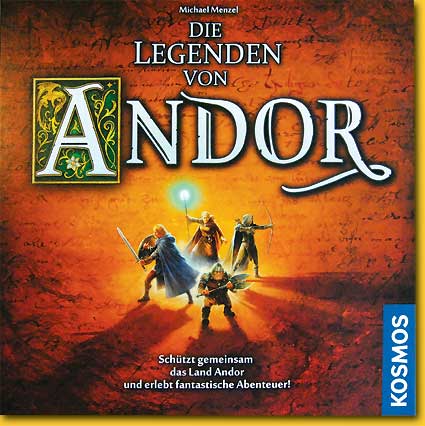 |
Experience adventures, simply from your armchair; who does not want to do this? This possibility is given us in ‘Die Legenden von Andor’/’ Legends of Andor’ in which each of the two to four players take acts as a hero, and with their special abilities confront the unknown danger. In five consecutive scenarios the heroes are exposed to ever-changing and increasing in difficulty hazards.
‘Andor’ has won several prestigious awards in the mean time, including the important German ‘Spiel des Jahres’ prize. Does the acclaimed game live up to the expectations of the experienced player?
|
|
|
| x |
|
|
|
|
|
|
|
|
|
|
|
|
|
|
|
|
|
|
|
|
|
|
|
|
|
|
|
|
|
|
|
|
|
|
|
|
|
|
|
|
|
|
|
|
|
|
|
|
|
|
|
|
|
|
|
|
|
|
|
|
|
|
Without much ado the player is led into the game: he is a heroe as we all are whackers, and he takes the corresponding game materials he begins the game with. Experiencing adventures is what we’re going to do; the suspense at the table is noticeable, similar to a ride in the Black Mamba: whether and where we will scream and how fast the ride will be, and whether our stomach will endure the dizzying fall that most surely will lie ahead somewhere on the track; we don’t know. In the case of ‘Andor’ will power and strength are of all heroes concern, admitted: sligthly less spectacular but no less important to be able to succesfully finish any of the adventures.
|
|
|
| x |
|
|
|
|
|
|
|
|
|
|
|
|
|
|
|
|
|
|
|
|
|
|
|
|
|
|
|
|
|
|
|
|
|
|
|
|
|
|
|
|
|
|
|
|
|
|
|
|
|
|
|
|
|
|
|
|
|
|
|
|
|
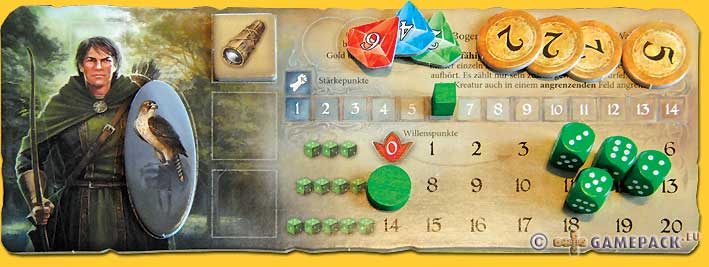 |
|
|
|
| x |
|
|
|
|
|
|
|
|
|
|
|
|
|
|
|
|
|
|
|
|
|
|
|
|
|
|
|
|
|
|
|
|
|
|
|
|
|
|
|
|
|
|
|
|
|
|
|
|
|
|
|
|
|
|
|
|
|
|
|
|
|
|
The double sided game board shows a landscape on one side, with a quite prominent castle which must be defended against oncoming monsters, or where healing herbs must be brought to. The other side of the board depicts an underground mine system; this board is used in only one of the scenarios. Often only gradually the goal of the scenario becomes clear.
|
|
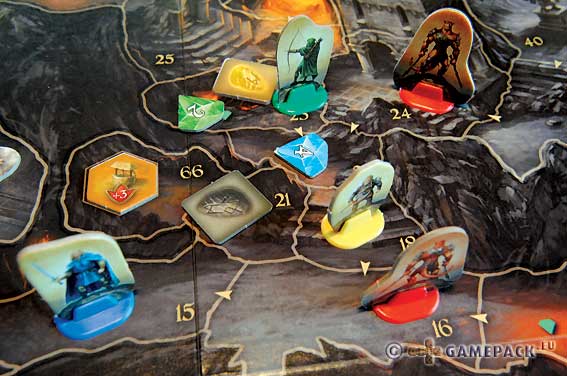 |
|
|
| x |
|
|
|
|
|
|
|
|
|
|
|
|
|
|
|
|
|
|
|
|
|
|
|
|
|
|
|
|
|
|
|
|
|
|
|
|
|
|
|
|
|
|
|
|
|
|
|
|
|
|
|
|
|
|
|
|
|
|
|
|
|
|

|
|
This is done by special legend cards that at the start of a scenario are placed at sometimes fixed, sometimes variable places next to the game board, and that correspond with a letter on the socalled narrator track, a track running from letter A to N along which a token, the narrator, gradually moves step by step; usually when a monster is defeated but always at the end of a day.
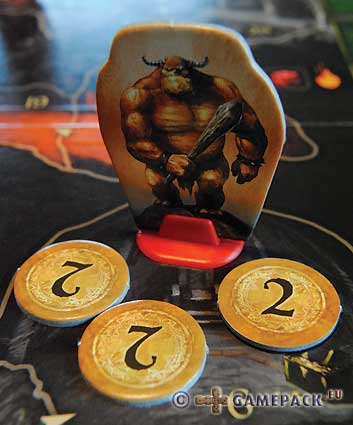 |
|
|
| xx |
|
|
|
|
|
|
|
|
|
|
|
|
|
|
|
|
|
|
|
|
|
|
|
|
|
|
|
|
|
|
|
|
|
|
|
|
|
|
|
|
|
|
|
|
|
|
|
|
|
|
|
|
|
|
|
|
|
|
|
|
|
|
A working day lasts seven hours, but a hero may do overtime against two power points for each additional hour, with a maximum of three hours. Each area a hero moves into costs one hour. When there is a monster in that area, the heroe may fight it, ‘paying’ one hour. The four heroes may fight alone or together agianst the monsters, and for the stronger monsters this is an advisable must. When a monster is defeated, the heroes may collect money or will power, to be divided among the participating trouppe members.
|
|
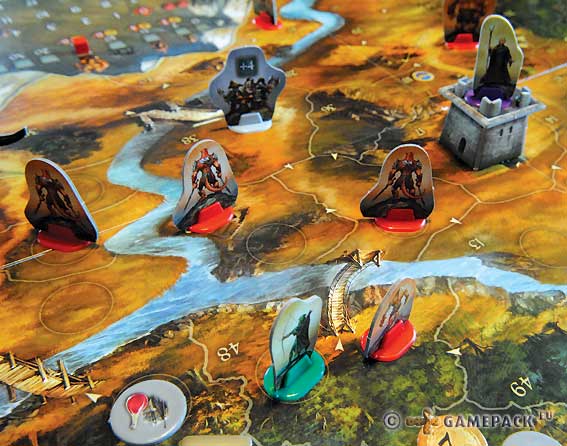 |
|
|
| x |
|
|
|
|
|
|
|
|
|
|
|
|
|
|
|
|
|
|
|
|
|
|
|
|
|
|
|
|
|
|
|
|
|
|
|
|
|
|
|
|
|
|
|
|
|
|
|
|
|
|
|
|
|
|
|
|
|
|
|
|
|
 |
|
Scattered over the game board are four wells where the heroes can refresh and in doing so power up their will power. Scenario 1, an entry scenario, is very simple (hello Kennerspiel?) and has a very limited length; from scenario 2 the adventure really begins, and now the trader has opened his shops on a few places where the heroes can buy weaponry, but also handy tools like binoculars or a falcon, with which stuff from one player to another can be transferred.
|
|
|
| x |
|
|
|
|
|
|
|
|
|
|
|
|
|
|
|
|
|
|
|
|
|
|
|
|
|
|
|
|
|
|
|
|
|
|
|
|
|
|
|
|
|
|
|
|
|
|
|
|
|
|
|
|
|
|
|
|
|
|
|
|
|
| Using the binoculars informs a hero what is in adjacent fog areas, which is quite handy as a hero sometimes does not want to accidentally activate a monster there, or if the hero is on the search for the witch who possesses a very powerful potion that can be bought there for expensive money and which enables the hero to double the outcome of his die in a fight. |
|
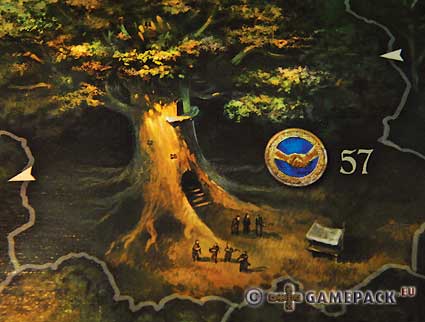 |
|
|
| x |
|
|
|
|
|
|
|
|
|
|
|
|
|
|
|
|
|
|
|
|
|
|
|
|
|
|
|
|
|
|
|
|
|
|
|
|
|
|
|
|
|
|
|
|
|
|
|
|
|
|
|
|
|
|
|
|
|
|
|
|
|
 |
|
At the end of the day an event card is drawn from a deck of cards; there are three different decks of event cards that are used in various scenarios. One scenario has some more positive cards/effects than others, but in general it remains to bes een whether the bunch is not affected by any kind of disaster, such as the forced release of will power. At the same time, but in strict order, the monsters are moved, women and children first or at least from small to large, and within each category the monster on the lowest numbered area first.
|
|
|
| x |
|
|
|
|
|
|
|
|
|
|
|
|
|
|
|
|
|
|
|
|
|
|
|
|
|
|
|
|
|
|
|
|
|
|
|
|
|
|
|
|
|
|
|
|
|
|
|
|
|
|
|
|
|
|
|
|
|
|
|
|
|
| When at any time monsters enter the castle, thay are placed on a special parking lot applicable to the number of players. If space runs out, the scenario is lost and the legend end card ‘N’ is read that may or may not give advice on how to play different and hopefully do better next time. The scenario also is lost when the narrator token has reached the ‘N’ field and the heroes failed to meet the end condition for that scenario. |
|
|
| x |
|
|
|
|
|
|
|
|
|
|
|
|
|
|
|
|
|
|
|
|
|
|
|
|
|
|
|
|
|
|
|
|
|
|
|
|
|
|
|
|
|
|
|
|
|
|
|
|
|
|
|
|
|
|
|
|
|
|
|
|
|
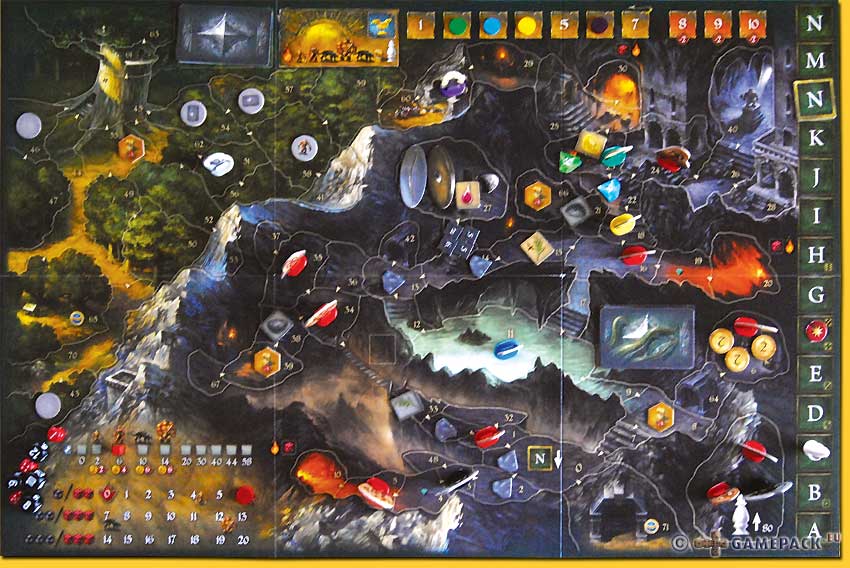 |
|
| x |
|
|
| x |
|
|
| x |
|
|
 |
|
|
|
|
|
|
|
|
|
|
|
|
|
|
|
|
|
|
|
|
|
|
|
|
|
|
|
|
|
|
|
|
|
|
|
|
|
|
|
|
|
|
|
|
|
|
|
|
|
|
|
|
|
The above description only partly does justice to the richness of the game and its atmosphere. The ability to fight monsters with better equipmen, from bow and witch potion to healing herbs and a black power die each contributes to a rich feel. ‘Andor’ is a cooperative game, and one must like this kind of game, but as far as I’m concerned ‘Andor’ is the best and most attractive so far. This is not least due to to the beautiful and also laureated artwork of which the game is infused; it is lovingly conceived and implemented by the author and illustrator Michael Menzel, with ‘Andor’ showing his first game as an author to the world.
|
|
|
| x |
|
|
|
|
|
|
|
|
|
|
|
|
|
|
|
|
|
|
|
|
|
|
|
|
|
|
|
|
|
|
|
|
|
|
|
|
|
|
|
|
|
|
|
|
|
|
|
|
|
|
|
|
|
|
|
|
|
|
|
|
|
 |
The scenarios gradually become harder to complete, and it usually takes a couple of times until everything falls into place and the heroes finally complete the given assignment(s). The falling in place can be taken quite literally: especially in scenario 4 and 5 dice determine the locations for various things such as gems and monsters. This makes that one time a scenario is easier to complete than another time. But especially in scenario 5, the last scenario, military precision is required to bring it to a successful conclusion.
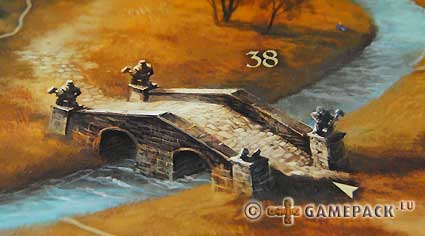
|
|
|
| x |
|
|
|
|
|
|
|
|
|
|
|
|
|
|
|
|
|
|
|
|
|
|
|
|
|
|
|
|
|
|
|
|
|
|
|
|
|
|
|
|
|
|
|
|
|
|
|
|
|
|
|
|
|
|
|
|
|
|
|
|
|
| The heroes must be careful to fight not too many monsters, as each defeated monster advances the narrator token, reaching the end field before the dragon is defeated. The position of the herbs can be favorable or less favorable; the amount of monsters at the start of the scenario that are placed in the castle can be doable or disappointing, and the position of the witch and Prince Thorald can be favorable or unfavorable in such a way -the heroes must search for these positions- that there is jus tor just not enough time left to fight the dragon. |
|
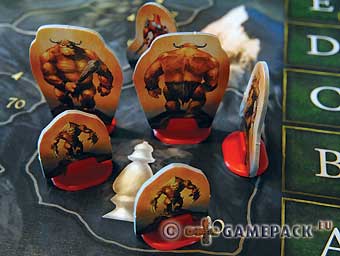 |
|
|
| x |
|
|
|
|
|
|
|
|
|
|
|
|
|
|
|
|
|
|
|
|
|
|
|
|
|
|
|
|
|
|
|
|
|
|
|
|
|
|
|
|
|
|
|
|
|
|
|
|
|
|
|
|
|
|
|
|
|
|
|
|
|
 |
|
Another thing about the military precision: in the last two scenarios it is in fact impossible to win when playing it for the first time. That’s okay, the experience helps the heroes in their next try. But at some point, it just means that the players quite bluntly must remember information from a previous -lost- game, such as when a certain event will take place and where; and thus in fact must have foreknowledge of and to avert the oncoming calameties: ‘If you move to that x area with the farmer, you are safe when the Skral turns up in that y area next turn’. At this point the mechanics break through the atmosphere of the game and in fact spoils a nice monster party.
|
|
|
| x |
|
|
|
|
|
|
|
|
|
|
|
|
|
|
|
|
|
|
|
|
|
|
|
|
|
|
|
|
|
|
|
|
|
|
|
|
|
|
|
|
|
|
|
|
|
|
|
|
|
|
|
|
|
|
|
|
|
|
|
|
|
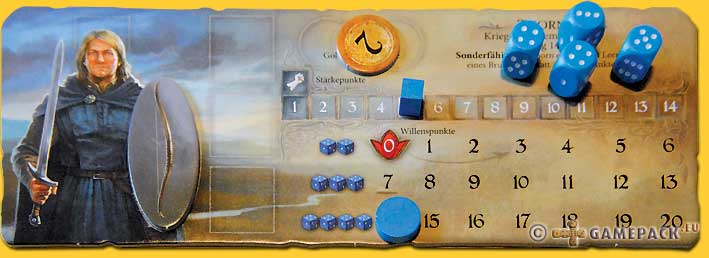 |
|
|
| x |
|
|
|
|
|
|
|
|
|
|
|
|
|
|
|
|
|
|
|
|
|
|
|
|
|
|
|
|
|
|
|
|
|
|
|
|
|
|
|
|
|
|
|
|
|
|
|
|
|
|
|
|
|
|
|
|
|
|
|
|
|
|
With only two players and thus two heroes the last two scenarios are undoable; the heroes lack flexability and mobility that four heroes do have. These latter two scenarios require all four heroes; two players can take two heroes each, but this cannot be the intention of the author.
|
|
|
| x |
|
|
|
|
|
|
|
|
|
|
|
|
|
|
|
|
|
|
|
|
|
|
|
|
|
|
|
|
|
|
|
|
|
|
|
|
|
|
|
|
|
|
|
|
|
|
|
|
|
|
|
|
|
|
|
|
|
|
|
|
|
|
Even guarded with 32 strength points, various herbs, three different coloured gems and thus a black strength die, the support of Prince Thorald and four(!) witch potions, even the sixth effort in defeating the dragon failed, although we almost made it several times. We stopped after the sixt attempt, and put ‘Andor’ away for awhile. New scenarios already have been downloaded, and most likely will get played, as goes for the announced expansion ‘Der Sternenschild’.
But it is just like a computer game: when a level is completed, one moves to the next; there is no challenge anymore to play the lower levels again. And, whilst comparing the game to a computer game: scenario 5 resembles a maze game: there seems to be only one way out, and only one way to complete it. And all has to come together, including the dice rolls.
|
|
 |
|
| x |
|
|
|
|
|
|
|
|
|
|
|
|
|
|
|
|
|
|
|
|
|
|
|
|
|
|
|
|
|
|
|
|
|
|
|
|
|
|
|
|
|
|
|
|
|
|
|
|
|
|
|
|
|
|
|
|
|
|
|
|
|
|
Despite the fun the game leaves a bitter taste behind. That is twofold: that two advanced scenarios (Kennerspiel ahoy!) cannot be played with two players, and that scenario 5 is so difficult and depends on so many coincidents that the challenge and the desire wanting to play it and trying again once more gradually decreases. It is for these two reasons -and the first time- that I will not rate an initially good and atmospheric game.
© 2013 Richard van Vugt
Die Legenden von Andor/Legends of Andor, Michael Menzel, Kosmos, 2012 - 2 to 4 players, 10 years and up, 60-90 minutes
|
|
|
 - - - - |
|
|
|
|
|
|
|
|
|
|
|
|
|
|
|
|
|
|
|
|
|
|
|
|
|
|
|
|
|
|
|
|
|
|
|
|
|
|
|
|
|
|
|
|
|
|
|
|
|
|
|
|
  |
|
|
|
|
|
|
|
|
|
|
|
|
|
|
|
|
|
|
|
|
|
|
|
|
|
|
|
|
|
|
|
|
|
|
|
|
|
|
|
|
|
|
|
|
|
|
|
|
|
|
|
|
  |
|
|
|
|
|
|
|
|
|
|
|
|
|
|
|
|
|
|
|
|
|
|
|
|
|
|
|
|
|
|
|
|
|
|
|
|
|
|
|
|
|
|
|
|
|
|
|
|
|
|
|
|
  |
Beautiful and atmospheric, but too calculating by the 'punishment' on defeating monsters |
|
|
|
|
|
|
|
| x |
|
|
|
|
|
|
|
|
|
|
|
|
|
|
|
|
|
|
|
|
|
|
|
|
|
|
|
|
|
|
|
|
|
|
|
|
|
|
|
|
|
|
|
|
|
|
|
|
|
|
|
|
|
|
|
|
|
|
|
|
|
| x |
|
|
|
|
|
|
|
|
|
|
|
|
|
|
|
|
|
|
|
|
|
|
|
|
|
|
|
|
|
|
|
|
|
|
|
|
|
|
|
|
|
|
|
|
|
|
|
|
|
|
|
|
|
|
|
|
|
|
|
|
|
 |
|
|
|
|
|
|
|
|
|
|
|
|
|
|
|
|
|
|
|
|
|
|
|
|
|
|
|
|
|
|
|
|
|
|
|
|
|
|
|
|
|
|
|
|
|
|
|
|
|
|
|
|
 |
|
|
|
|
|
|
|
|
|
|
|
|
|
|
|
|
|
|
|
|
|
|
|
|
|
|
|
|
|
|
|
|
|
|
|
|
|
|
|
|
|
|
|
|
|
|
|
|
|
|
|
|
| x |
|
|
|
|
|
|
|
|
|
|
|
|
|
|
|
|
|
|
|
|
|
|
|
|
|
|
|
|
|
|
|
|
|
|
|
|
|
|
|
|
|
|
|
|
|
|
|
|
|
|
|
|
|
|
|
|
|
|
|
|
|
 |
|
|
|
|
|
|
|
|
|
|
|
|
|
|
|
|
|
|
|
|
|
|
|
|
|
|
|
|
|
|
|
|
|
|
|
|
|
|
|
|
|
|
 |
|
|
|
|
|
|
|
|
|
|
|
|
|
|
|
|
|
|
|
|
|
|
|
|
|
|
|
|
|
|
|
|
|
|
|
|
|
|
|
|
|
|